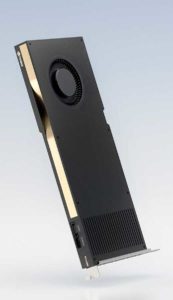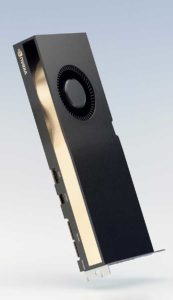NVidia is hosting the third online iteration of their “GTC” GPU Technology Conference. The first one was hurriedly implemented last March, as we were just beginning to realize the implications of the Covid issue. NVidia then turned what had previously been a regional version of GTC conference in the Fall into a better planned global online event, once other companies had figured out some smoother practices and infrastructure for these virtual conferences. Now we have GTC 2021 this week, with a number of new hardware and software announcements.
On the hardware front, we have four new PCIe based GPU cards, which are scaled back versions of the previously announced A6000 and A40. The new A5000 and A4000 are new Ampere generations of the previous Turning based Quadro RTX 5000 and 4000. The new cards have 2.5 times as many CUDA cores as their predecessors, and 8GB more RAM. The A5000 has 8K cores, and 24GB RAM, while the A4000 has 6K cores and 16GB RAM. This makes them the professional equivalents of the GeForce 3080 and 3070 respectively, but with more RAM. The A4000 seems like the ideal professional card for video editors and others who need professional GPU processing, but not the overpriced 3D performance of the A6000.
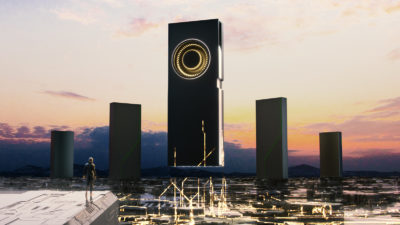 On the server and virtualization side, the A10 replaces the T4, and sits between the A5000 and A4000 performance-wise. The A16 replaces the existing M10 as a 4x GPU card, with 64 GB RAM in total, targeting remote desktop hosting.
On the server and virtualization side, the A10 replaces the T4, and sits between the A5000 and A4000 performance-wise. The A16 replaces the existing M10 as a 4x GPU card, with 64 GB RAM in total, targeting remote desktop hosting.
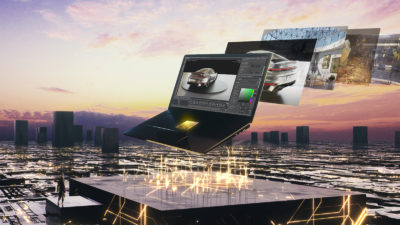 The other major hardware announcement is the mobile line of professional GPUs, scaling from the A5000 down to the T600. The mobile A5000 has 6K cores, doubling the number of cores from the previous generation RTX 5000 mobile GPUs. This scales down to 5K cores in the A4000, and 4K cores in the A3000, and 2560 cores in the new A2000, which matches the specs of the previous 2nd tier Quadro RTX 4000. So we are seeing a huge increase over the previous generation, but compared to the desktop cards, we are no longer seeing parity between the PCIe product naming, and the mobile solution labels. The new mobile A5000 is equal to the desktop A4000, which makes the entire naming convention really difficult to intuitively decode or understand. Suffice to say that the new products are much faster than the old products, but it is difficult to compare them to each other. Similar to dropping the Quadro branding, NVidia seems to be taking steps to make it more difficult to keep track of or compare their different product offerings. And I say this as a huge fan of NVidia’s products: “this confusion is not helping your end users.”
The other major hardware announcement is the mobile line of professional GPUs, scaling from the A5000 down to the T600. The mobile A5000 has 6K cores, doubling the number of cores from the previous generation RTX 5000 mobile GPUs. This scales down to 5K cores in the A4000, and 4K cores in the A3000, and 2560 cores in the new A2000, which matches the specs of the previous 2nd tier Quadro RTX 4000. So we are seeing a huge increase over the previous generation, but compared to the desktop cards, we are no longer seeing parity between the PCIe product naming, and the mobile solution labels. The new mobile A5000 is equal to the desktop A4000, which makes the entire naming convention really difficult to intuitively decode or understand. Suffice to say that the new products are much faster than the old products, but it is difficult to compare them to each other. Similar to dropping the Quadro branding, NVidia seems to be taking steps to make it more difficult to keep track of or compare their different product offerings. And I say this as a huge fan of NVidia’s products: “this confusion is not helping your end users.”
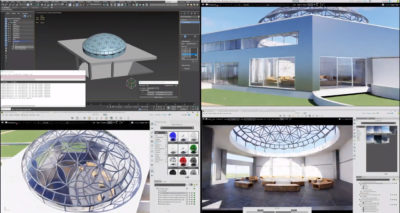 On the software front, NVidia’s Omniverse is the culmination of a number of technologies being combined, to greatly enhance 3D workflows and collaboration between different apps and users. Based on Pixar’s USD universal scene descriptions, it can link the 3D assets being working on in applications from completely different vendors. On a single system, it appears to work like Adobe Dynamic Link, where changes made in one program show up immediately on assets in a separate application. But in other ways it is similar to the role of NDI for real-time workflows, sharing content between systems on a network, or across the internet. The individual user version is a free tool, but the Nucleus server that allows sharing between multiple users will be an Enterprise level solution in the cloud.
On the software front, NVidia’s Omniverse is the culmination of a number of technologies being combined, to greatly enhance 3D workflows and collaboration between different apps and users. Based on Pixar’s USD universal scene descriptions, it can link the 3D assets being working on in applications from completely different vendors. On a single system, it appears to work like Adobe Dynamic Link, where changes made in one program show up immediately on assets in a separate application. But in other ways it is similar to the role of NDI for real-time workflows, sharing content between systems on a network, or across the internet. The individual user version is a free tool, but the Nucleus server that allows sharing between multiple users will be an Enterprise level solution in the cloud. 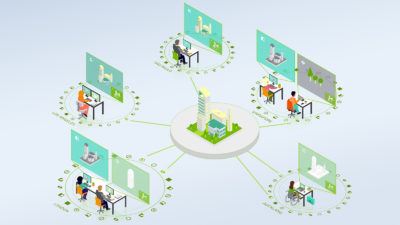 NVidia has also partnered with Apple to allow direct support of viewing Omniverse XR content on iPads and iPhones. I don’t personally do much work in 3D, but I can see the benefits of what they have developed here, and I am sure it will make a lot of people’s creative 3D work much easier and more efficient.
NVidia has also partnered with Apple to allow direct support of viewing Omniverse XR content on iPads and iPhones. I don’t personally do much work in 3D, but I can see the benefits of what they have developed here, and I am sure it will make a lot of people’s creative 3D work much easier and more efficient.
NVidia also announced their new line of “Grace” ARM processors, that are not yet available, but after their initial debut in datacenter servers, they may eventually make it into consumer systems. While this probably isn’t going to totally replace Intel’s x86 CPUs anytime soon, Apple’s M1 architecture demonstrates that NVidia isn’t the only company betting that x86 processing can be replaced in many new applications. So while Grace based products aren’t go to impact your work immediately, it may be the first step towards a big change much farther in the future.
Beyond the new products that are announced at the conference, there are also hundreds of sessions where attendees can learn about different technologies and their implementations from NVidia’s staff and their top users. I am looking forward to Rob Legato’s session on virtual cinematography, and a round table on in camera VFX that are both scheduled for mid-day Wednesday. Since the online version of GTC is free to attendees, you are welcome to check them out too, as well as hundreds of other sessions available to watch.

